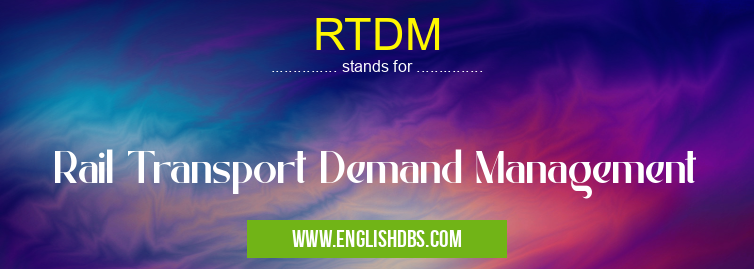What does RTDM mean in MANAGEMENT
RTDM (Rail Transport Demand Management) refers to a set of strategies and techniques used to manage and influence the demand for rail transportation services. By implementing RTDM measures, transportation providers aim to optimize the utilization of existing infrastructure, increase ridership, and reduce congestion during peak periods.

RTDM meaning in Management in Business
RTDM mostly used in an acronym Management in Category Business that means Rail Transport Demand Management
Shorthand: RTDM,
Full Form: Rail Transport Demand Management
For more information of "Rail Transport Demand Management", see the section below.
» Business » Management
Purpose of RTDM
- Optimize Infrastructure Utilization: RTDM helps rail operators make efficient use of limited infrastructure capacity by distributing demand more evenly throughout the day.
- Increase Ridership: By offering incentives and improving service quality during off-peak times, RTDM encourages ridership during periods when trains are less crowded.
- Reduce Congestion: By shifting demand away from peak hours, RTDM mitigates overcrowding and delays, improving the overall travel experience for commuters.
Key Strategies
- Pricing Incentives: Adjusting fares based on time of day or demand can encourage commuters to travel during off-peak hours.
- Service Improvements: Enhancing service frequency, reliability, and amenities during off-peak times can attract riders who would otherwise opt for alternative modes of transportation.
- Information Provision: Providing real-time information about train schedules, delays, and alternative transportation options empowers commuters to make informed decisions and choose the best travel time.
- Employer Partnerships: Collaborating with employers to offer flexible work schedules or incentives for employees to travel during non-peak hours.
- Public Education: Raising awareness about the benefits of off-peak travel and the impact of congestion on the transportation system.
Benefits of RTDM
- Improved Passenger Experience: Reduced overcrowding and delays lead to a more comfortable and reliable travel experience.
- Increased Infrastructure Efficiency: Optimizing capacity utilization allows for more efficient use of existing infrastructure, reducing the need for costly expansion projects.
- Environmental Sustainability: By shifting demand away from peak hours, RTDM reduces emissions associated with congestion and idling trains.
- Economic Vitality: Improved rail transportation services attract businesses and residents, contributing to economic growth and development.
Essential Questions and Answers on Rail Transport Demand Management in "BUSINESS»MANAGEMENT"
What is Rail Transport Demand Management (RTDM)?
RTDM refers to strategies and measures aimed at influencing the demand for rail transport services, with the goal of optimizing the use of rail infrastructure and resources.
Why is RTDM important?
RTDM is crucial for maximizing the efficiency and capacity of rail networks. It helps to:
- Manage peak demand periods
- Optimize service frequencies and schedules
- Reduce congestion and delays
- Improve passenger satisfaction and rail service reliability.
What are some common RTDM strategies?
RTDM strategies typically include:
- Pricing incentives (e.g., peak-hour surcharges, off-peak discounts)
- Capacity management (e.g., adjusting train frequencies, adding additional carriages)
- Demand forecasting and modeling
- Integrated ticketing systems
- Marketing and awareness campaigns.
How does RTDM benefit rail operators?
RTDM enables rail operators to:
- Increase revenue by maximizing capacity utilization
- Reduce operational costs by optimizing service levels
- Improve customer satisfaction through reduced congestion and delays
- Enhance the overall efficiency and sustainability of rail networks.
How does RTDM benefit passengers?
RTDM provides passengers with:
- More reliable and frequent rail services
- Reduced travel times and congestion
- Improved access to rail services through flexible pricing and integrated ticketing
- A more pleasant and comfortable travel experience.
Final Words: RTDM plays a crucial role in managing rail transport demand, optimizing infrastructure utilization, increasing ridership, and reducing congestion. By implementing a range of strategies and engaging with stakeholders, transportation providers can enhance the efficiency and effectiveness of their rail systems, benefiting commuters, businesses, and the environment.
